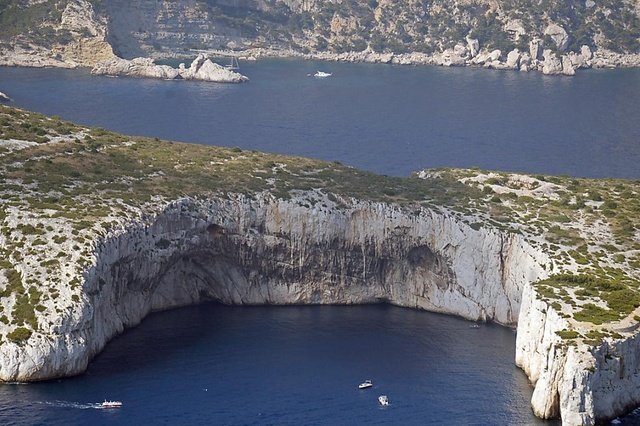Artificial reefs at the outlet of an old Marseille sewer

In the heart of the National Park of Calanques leads a conduit called "the anus of Marseille", which for a century, has carried waste water from the second city of France and devastated the seabed. An experimental project hopes to revive them.
In a postcard landscape, at the foot of the cliffs of the cove of Cortiou, a crane boat carefully immerses a block of concrete, "fish hotel" of ten tons.
The operation, dubbed Rexcor, aims to build four "villages" underwater concrete: 300 tons of artificial reefs, as we install in many coastal sites around the planet, but specially calibrated to study the return of life in murky waters, according to the promoters of this project.
"These reefs must withstand swells up to nine meters high, and hold at least thirty years," says from the deck of the boat Alexandre Musnier, project manager for the start-up Montpellier Seaboost.
Twenty meters below the surface, a curtain of suspended sediments hides the white sun of the Mediterranean Sea. The bottom is sorry and muddy, noted an AFP photographer. A cloud of particles rises when the concrete block is deposited.
Dirty water
The water quality has improved over the last thirty years, and despite the flowery name given by residents to the evacuation pipe, the discards are now in compliance with the standards, underline the promoters of the project, headed by the National Park and the State, via the Water Agency.
In the 1980s, "the construction of the treatment plant in the city has 'cut down' the levels of bacteria," says AFP Anthony Caro, responsible for the subject at the City Hall of Marseille. "We can now consider recolonizing".
Not enough to make you want to take a dip, however: the treatment does not filter certain metals, drug waste or microplastics, and the water is contaminated in case of violent storms, frequent in the Mediterranean.
Nevertheless, "we will try to recreate small ecosystems to give a boost to nature," says project biologist Matthieu Lapinski. This is "to know if we can restore some ecological functions that have completely disappeared".
Heresy
A heresy, according to the Union Calanques Littoral association, which fears contaminations and opposes what it describes as "HLM under the sea". "The fishes invited to colonize these artificial structures, in this insanitary environment, will have the chance to find there at the same time the lodging and the cover", ironises she, quoting the PCBs, nickel, lead, and other residues anti-inflammatory ...
"We are far from the sanitary level of a situation that allows a biological restoration.The prerequisite should have been to stop nuisances or reduce them much more", also criticizes Sandrine Ruitton, scientist at the Mediterranean Institute of Ocean Sciences.
The budget of the project, one million euros, "could have been used for something more effective, for example to test the resistance of species to the current environmental conditions", adds this member of the scientific council of the Park of the Calanques, reserved on prospects for recolonization.
Algae and small fish
Rudimentary (tires, concrete slabs) or more sophisticated, artificial reef projects are legion on the French coast since the 1960s. In 2012, a report of the State deplored the lack of experience feedback sufficient to "draw definitive lessons "on their interest.
In Cortiou, fish counting dives are planned for three years, even if their return could take even more time. The reefs are removable, in case the experience runs out.
Biologists hope for the rapid return of algae, enough to attract small fish, then their predators ... And so on: "the ultimate goal is to have the upper links of the food chain", details M Lapinski.